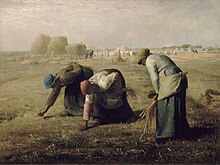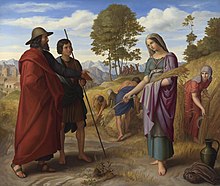Cropping


The harvesting of grain , often also referred to as gleaning , was a common harvesting method of the lower social classes of a village. At harvest time, the ears of wheat that had remained in the field after the grain had been cut and removed were searched for and collected.
In addition to ears of wheat, leftover fruit was also collected from fields, vineyards or trees after the harvest had already taken place .
The reading was traditionally done by the poor who did not own property , often also by children. Today it is also carried out on a large scale by humanitarian organizations, for example in fields that are not harvested for economic reasons. In some areas of Germany there is still a custom today to allow needy people to read in the orchards (also called “stopping” in the Palatinate).
The practice was and is often protected by law (right of reading). At other times it was and is fundamentally forbidden to read other fields without explicit permission.
The right to read the Bible
In some places in the Old Testament of the Bible , a right of reading is described:
- Leviticus 19 : 9 “And when you reap the harvest of your land, you must not completely reap the edge of your field and you must not glean your harvest”.
- Deuteronomy 24:19 “If you bring in your harvest in your field and you have forgotten a sheaf in the field, you should not turn back to fetch it. It should be for the stranger, for the orphan and for the widow. "
- Deuteronomy 24:21 “When you are reading in your vineyard, you should not be reading afterwards. For the stranger, the orphan and for the widow it should be "
In the Book of Ruth , the Moabite woman reads the ears of corn in the harvested fields of her distant relative Boas .
Legal situation today
At least in France there is still the explicit right to collect what is left, as presented in the documentary Les glaneurs et la glaneuse ( 2000/2002 ) by Agnès Varda . Here the practice of gleaning is shown from the point of view of the rural population of France.
Originally, this right to glaner (French for “pick up”, “collect”) refers to what remains in the field after the harvest.
